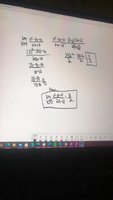Hi. I need this checked please. LLP
View attachment 20993
rachelmaddie, your method would be to approximate the limit.
You have errors. 4.97/-0.02 is not equal to, nor is it approximately
equal to, 3.5. Also, 3.5 is not the correct value for your approximation.
For x = 4.99, the numerator is -0.0699 exactly and the denominator is
-0.02 as you have shown it. Therefore, the value of that fraction is 3.495.
Done in a similar way for x = 5.01, the value of that fraction is 3.505.
From this work, you don't know that the limit is 3.5 as x approaches 5.
It appears so.
Instead, look at factoring the parts of the algebraic fraction and reduce
before substituting x = 5 to evaluate the limit. Using the binomial factor
from the denominator as I gave here can often make it easier to factor
the expression in the numerator.
\(\displaystyle \dfrac{( \ \ \ \ \ \ \ \ \ )( \ \ \ \ \ \ \ \ \ )}{2(x - 5)}\)

